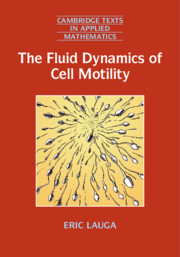Book contents
- Frontmatter
- Dedication
- Contents
- Preface
- Part One Fundamentals
- Part Two Cellular Locomotion
- Part Three INTERACTIONS
- 10 Swimming Cells in Flows
- 11 Self-Propulsion and Surfaces
- 12 Hydrodynamic Synchronisation
- 13 Diffusion and Noisy Swimming
- 14 Hydrodynamics of Collective Locomotion
- 15 Locomotion and Transport in Complex Fluids
- References
- Index
12 - Hydrodynamic Synchronisation
from Part Three - INTERACTIONS
Published online by Cambridge University Press: 09 September 2020
- Frontmatter
- Dedication
- Contents
- Preface
- Part One Fundamentals
- Part Two Cellular Locomotion
- Part Three INTERACTIONS
- 10 Swimming Cells in Flows
- 11 Self-Propulsion and Surfaces
- 12 Hydrodynamic Synchronisation
- 13 Diffusion and Noisy Swimming
- 14 Hydrodynamics of Collective Locomotion
- 15 Locomotion and Transport in Complex Fluids
- References
- Index
Summary
It has long been observed that an ensemble of flagella or cilia can synchronise their periodic beating. A long-standing hypothesis is that hydrodynamic interactions may provide a systematic route towards synchronisation. In this twelfth chapter we focus on the role played by fluid mechanics and highlight how interactions through the viscous fluid may lead to synchronised beating consistent with experiments. We start by the case where flagella, or cilia, are anchored on a surface or on an organism. We use a minimal model of spheres undergoing cyclic motion above a surface and interacting hydrodynamically in the far field. We show that in-phase synchronisation can be achieved if the spheres move along compliant paths or if the forcing responsible for their motion is phase-dependent, capturing experimental observations. We then address the synchronisation of free-swimming cells such as spermatozoa. Using a two-dimensional model we show the additional degree of freedom may lead to passive synchronisation in a manner that depends only on the geometry, but might not minimise energy dissipation. In contrast, active synchronisation always leads to in-phase swimming, as observed in experiments.
Keywords
- Type
- Chapter
- Information
- The Fluid Dynamics of Cell Motility , pp. 226 - 268Publisher: Cambridge University PressPrint publication year: 2020



